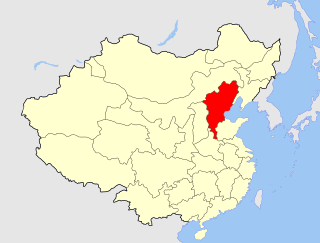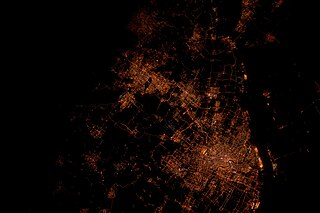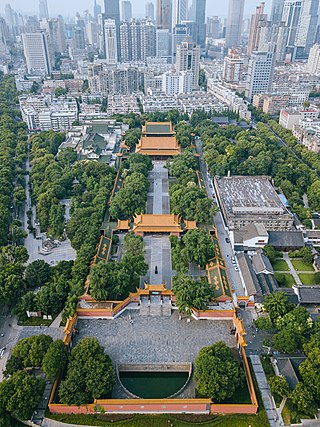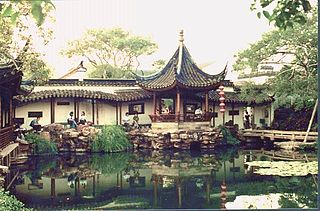Prior to 3rd century
| Part of a series on the | ||||||||||||||
| History of China | ||||||||||||||
|---|---|---|---|---|---|---|---|---|---|---|---|---|---|---|
| | ||||||||||||||
| ||||||||||||||
| ||||||||||||||
| ||||||||||||||
- 7000 BCE - Beiyinyang Neolithic people active. [1]
- 472 BCE - Castle built near Yuhuatai by Yue (state). [2]
The following is a timeline of the history of the city of Nanjing, Jiangsu Province, China.
| Part of a series on the |
| History of China |
|---|
| |



Nanjing, alternatively romanized as Nanking, is the capital of Jiangsu province of the People's Republic of China. It is a sub-provincial city, and a megacity. The city has 11 districts, an administrative area of 6,600 km2 (2,500 sq mi), and a population of 9,423,400 as of 2021. Situated in the Yangtze River Delta region, Nanjing has a prominent place in Chinese history and culture, having served as the capital of various Chinese dynasties, kingdoms and republican governments dating from the 3rd century to 1949, and has thus long been a major center of culture, education, research, politics, economy, transport networks and tourism, being the home to one of the world's largest inland ports. The city is also one of the fifteen sub-provincial cities in the People's Republic of China's administrative structure, enjoying jurisdictional and economic autonomy only slightly less than that of a province. Nanjing has been ranked seventh in the evaluation of "Cities with Strongest Comprehensive Strength" issued by the National Statistics Bureau, and second in the evaluation of cities with most sustainable development potential in the Yangtze River Delta. It has also been awarded the title of 2008 Habitat Scroll of Honor of China, Special UN Habitat Scroll of Honor Award and National Civilized City. Nanjing is also considered a Beta city classification, together with Chongqing, Hangzhou and Tianjin by the Globalization and World Cities Research Network, and ranked as one of the world's top 100 cities in the Global Financial Centres Index.

The Grand Canal is the longest canal or artificial river in the world and a UNESCO World Heritage Site. Its main artery, known to the Chinese as the Jing–Hang or Beijing–Hangzhou Grand Canal, is reckoned to extend for 1,776 km (1,104 mi) and is divided into 6 main sections. The Jiangnan Canal runs from the Qiantang River at Hangzhou to the Yangtze River at Zhenjiang; the Inner Canal from the Yangtze at Yangzhou to the Huai River at Huai'an, which for centuries was also its junction with the former course of the Yellow River; the Middle Canal from Huai'an to the Nansi Lakes; the Lu Canal from the lakes past Jining and the present course of the Yellow River to the Wei River at Linqing; the Southern Canal from Linqing to the Hai River at Tianjin; and the Northern Canal from Tianjin to Tongzhou on the outskirts of Beijing. As such, it passes through the provinces and municipalities of Zhejiang, Jiangsu, Shandong, Hebei, Tianjin, and Beijing. Since 2013 and 2014, the Chinese government and UNESCO further recognize the Eastern Zhejiang Canal from Hangzhou to Ningbo and certain sites along the former Tongji and Yongji Canals as official components of the Grand Canal.

Jiangsu is an eastern coastal province of the People's Republic of China. It is one of the leading provinces in finance, education, technology, and tourism, with its capital in Nanjing. Jiangsu is the third smallest, but the fifth most populous and the most densely populated of the 23 provinces of the People's Republic of China. Jiangsu has the highest GDP per capita and second-highest GDP of Chinese provinces, after Guangdong. Jiangsu borders Shandong in the north, Anhui to the west, and Zhejiang and Shanghai to the south. Jiangsu has a coastline of over 1,000 kilometers (620 mi) along the Yellow Sea, and the Yangtze River passes through the southern part of the province.

Zhili, alternately romanized as Chihli, was a northern administrative region of China since the 14th-century that lasted through the Ming dynasty and Qing dynasty until 1911, when the region was dissolved, converted to a province, and renamed Hebei in 1928.

Zhenjiang, alternately romanized as Chinkiang, is a prefecture-level city in Jiangsu Province, China. It lies on the southern bank of the Yangtze River near its intersection with the Grand Canal. It is opposite Yangzhou and between Nanjing and Changzhou. Zhenjiang was formerly the provincial capital of Jiangsu and remains as an important transportation hub. As of the 2020 census, its total population was 3,210,418 inhabitants whom 1,266,790 lived in the built-up area made of the 3 urban districts. The town is best known both in China and abroad for Chinkiang vinegar, a fragrant black vinegar that is a staple of Chinese cooking.

Yangzhou, postal romanization Yangchow, is a prefecture-level city in central Jiangsu Province, East China. Sitting on the north bank of the Yangtze, it borders the provincial capital Nanjing to the southwest, Huai'an to the north, Yancheng to the northeast, Taizhou to the east, and Zhenjiang across the river to the south. Its population was 4,559,797 at the 2020 census and its urban area is home to 2,635,435 inhabitants, including three urban districts, currently in the agglomeration.

Jiangnan is a geographic area in China referring to lands immediately to the south of the lower reaches of the Yangtze River, including the southern part of its delta. The region encompasses the city of Shanghai, the southern part of Jiangsu Province, the southeastern part of Anhui Province, the northern part of Jiangxi Province and the northern part of Zhejiang Province. The most important cities in the area include Anqing, Changzhou, Hangzhou, Nanjing, Ningbo, Shaoxing, Suzhou, Wuxi, Wenzhou, Yangzhou and Zhenjiang.

The Yangtze Delta or Yangtze River Delta is a triangle-shaped megalopolis generally comprising the Wu Chinese-speaking areas of Shanghai, southern Jiangsu, northern Zhejiang and northern Jiangxi. The area lies in the heart of the Jiangnan region, where the Yangtze River drains into the East China Sea. Having fertile soil, the Yangtze Delta abundantly produces grain, cotton, hemp and tea. In 2021, the Yangtze Delta had a GDP of approximately US$4.3 trillion, about the same size as Japan.
The Nanjing City, or translated as the Walled city of Nanjing, etc., refers to the historical core of Nanjing city enclosed in the Nanjing City Wall built in the early Ming dynasty. The area is about 55 square kilometers. Presently, parts of Qinhuai, Jianye, Gulou and Xuanwu districts of Nanjing are in the enclosed area. Around the City there are waters, rivers or lakes, along with the city wall.
Nanjing means "southern capital" and is the name of the current capital of Jiangsu Province and a former capital of China. It was formerly romanized as Nanking, Nan-ching, and Nankin.

The Ming Palace, also known as the "Forbidden City of Nanjing", was the 14th-century imperial palace of the early Ming dynasty, when Nanjing was the capital of China.

The Chaotian Palace, is located in Nanjing, China. It was built as an imperial palace in the Ming dynasty, and today it is known as the Nanjing Municipal Museum. Chaotian Palace area has the largest preserved traditional Chinese architectural complex in Jiangnan.

Lower Yangtze Mandarin is one of the most divergent and least mutually-intelligible of the Mandarin languages, as it neighbours the Wu, Hui, and Gan groups of Sinitic languages. It is also known as Jiang–Huai Mandarin, named after the Yangtze (Jiang) and Huai Rivers. Lower Yangtze is distinguished from most other Mandarin varieties by the retention of a final glottal stop in words that ended in a stop consonant in Middle Chinese.
The Nanjing dialect, also known as Nankingese, Nanjingese and Nanjing Mandarin, is the prestige dialect of Mandarin spoken in the urban area of Nanjing, China. It is part of the Jianghuai group of Chinese varieties.

The Jiangnan Examination Hall, near the Confucius temple, is located in the southern part of Nanjing, Jiangsu Province, China. It is the largest examination hall for imperial examination in ancient China. It now houses the Imperial Examination Museum.
Yangzhou, Yangchow or Yang Province was one of the Nine Provinces of ancient China mentioned in historical texts such as the Tribute of Yu, Erya and Rites of Zhou.

Jiangnan, formerly romanized as Kiangnan, was a historical province of the early Qing Empire. Its capital was Jiangning, from which it is sometimes known as Nanjing or Nanking Province. Established in 1645 during the Manchu conquest of Ming China, it administered the area of the earlier Ming province of Nanzhili, reaching from north of the Huai River—at the time the course of the Yellow River—to south of the Yangtze River in East China. Its territory was later divided into the separate provinces of Jiangsu and Anhui during the reign of the Qianlong Emperor (1736–1795), although the exact timing is disputed. Under the Republic and People's Republic of China, an area of Jiangsu also became the provincial-level municipality of Shanghai.
The Jianghuai people are people from Jianghuai over the floodplains and the estuary of the Yangtze River region. The word Jianghuai is a geographical and cultural definition of the people group living in the historical Liangjiang (两江) area, southeastern Henan province, Suzhou, and the central region of Anhui province.

Nanzhili, formerly romanized as Nan-chih-li and also known as South or Southern Zhili or Chih-li, was a historical province of the Ming Empire. Its capital was Nanjing, from which it is also sometimes known as Nanjing or Nanking Province. Nanzhili combined areas of the Yuan provinces of Henan Jiangbei and Jiangzhe and took its name—Chinese for "Southern Directly Administered Area"—from Nanjing's status as the Ming's national capital under the Hongwu Emperor and as the secondary capital after the Yongle Emperor's move to Beijing, which oversaw Beizhili or the Northern Directly Administered Area. During the early Qing Dynasty, Nanzhili was renamed Jiangnan and then divided into the separate provinces of Jiangsu and Anhui. Under the Republic and People's Republic of China, an area of Jiangsu also became the provincial-level municipality of Shanghai.
There have been several battles set in and around the city of Nanjing, China. Nanjing was previously named Jianye and Jiankang. During the 19th and 20th centuries, Nanking was a popular romanization of the name in European sources. The Battle of Nanjing may refer to:
Nanking
{{cite book}}: CS1 maint: location missing publisher (link){{citation}}: CS1 maint: location missing publisher (link)This article incorporates information from the Chinese Wikipedia.
Published in the 14th–19th centuries
Published in the 20th century
{{citation}}: CS1 maint: location missing publisher (link)Published in the 21st century